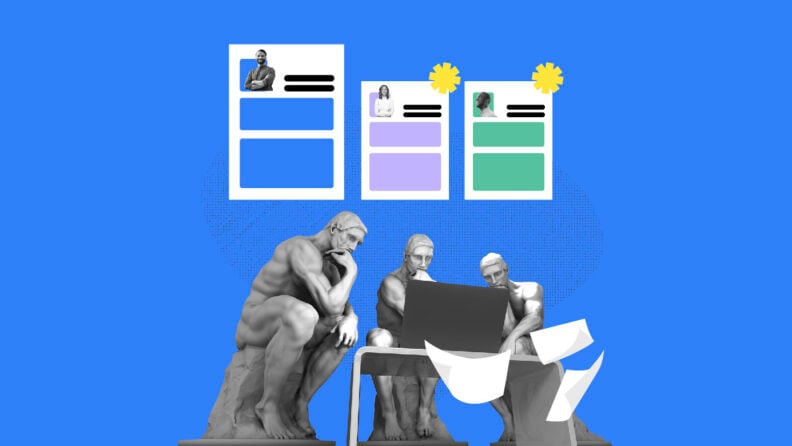Like painting a picture or writing a book, one of the hardest parts of recruitment software implementation is starting.
A well-executed implementation process ensures that the software aligns with your recruitment goals, enhances efficiency, and improves the overall candidate experience. But implementation? Well, that takes a bit of time, a big helping of effort, and a healthy serving of patience to navigate.
In this article, I'll walk you through the essential steps for a successful recruitment software implementation and leave you with some tips from people who have been through it.
Planning Your Recruitment Software Implementation
Before you start implementing any new software, never mind one as cumbersome and interconnected with the rest of your HR tech stack as your recruiting solution, you had better sit down and put together a plan for how you’re going to do it.
The planning phase typically looks like this.
Defining your recruitment goals
Identifying specific objectives is the first step in planning your recruitment software implementation. Clear goals for your recruiting strategy should guide the entire process and help you measure success.
Common recruitment goals that you’re looking to address through a new recruiting solution include reducing time-to-hire, improving candidate quality, and enhancing the candidate experience.
If your goal is to reduce time-to-hire by 20%, this objective will influence how you configure the software and who you train to use it. If you’re going to become more efficient, every member of a hiring team will need training to avoid becoming the bottleneck that slows the whole process down.
Assessing your current recruitment process
Conducting an audit of your existing workflows will help you understand the who, what, where, why, and how of what’s involved in changing your process to make the most of your new software.
Evaluate each step of your recruiting funnel, from job posting to onboarding, to identify pain points and areas for improvement. This assessment informs how you configure the software to address these issues.
For instance, if manual resume screening is a bottleneck, ensure the software has robust resume parsing tools and is easy to use for recruiting leads, who are often the first point of contact with a candidate, will be essential.
Selecting the implementation team
A successful implementation requires a dedicated team. Key roles include a project manager, HR representatives, IT support, and end-users.
Cross-departmental involvement ensures that all perspectives are considered. Choose team members based on their expertise and assign clear responsibilities to keep the project on track.
Pre-Implementation Steps
You know how you have to pick up the kids and dogs toys before you start vacuuming? Well, that’s what you’re doing with your pre-implementation plan.
It’s an important part of being prepared for implementation and will make your, and everyone else’s, life a lot easier once you get started.
Here are some steps to include in a pre-implementation checklist:
Data migration and cleaning
Data migration involves moving candidate records, job postings, and other relevant information to the new system.
Preparing your existing data for transfer will keep you from having to fix errors, duplicates, and misplaced or poorly formatted data later on.
Customizing the software
Tailoring the software to your specific processes enhances its effectiveness. Balance customization with out-of-the-box functionality to avoid overcomplicating the system. Your IT team will have a significant role to play in providing insights that fuel your decisions here.
Involve end-users in customization decisions to ensure the software meets their needs and increases user adoption.
Tip: Free recruiting systems are an excellent starting point to streamline the recruitment software implementation process, though it may have less customization options.
Consider the timing
If you're changing your tech and introducing something new to your staff, doing it during the busiest and most crucial part of your calendar isn't the time to make that shift.
For recruiting software, implementing during the busiest hiring windows of the calendar year in January-February or September-October is not a conducive to helping your team achieve its desired results.
Integration with existing systems
Integrating the recruitment software with existing systems, such as HRIS, payroll, and background check systems, is vital for seamless operations.
Address technical aspects like data mapping and API connections to ensure smooth data flow between systems.
The Implementation Process
Alright, you’ve laid the foundation for a successful implementation. Now the small matter of actually doing it.
Here are the key aspects of a successful implementation.
Software installation and configuration
Installing the recruitment software involves setting up servers, databases, and user access.
Differences between on-premise and cloud-based recruitment software implementations include infrastructure requirements and scalability options. Follow initial configuration best practices, such as defining user roles and setting up security protocols.
User training and adoption
Effective training is key to user adoption. Offer various training approaches, such as in-person sessions, online courses, and detailed documentation.
Role-specific training ensures that each user understands how to utilize the software effectively. Encourage adoption by highlighting the software's benefits and providing ongoing support, particularly in cases where artificial intelligence (AI) is involved.
AI in recruiting is becoming more common, but not all users are familiar with or trained on how to make the most of this new AI technology for recruiting.
Testing and quality assurance
Thorough testing of all software features and integrations is essential. User acceptance testing (UAT) involves real users testing the system to ensure it meets their needs.
Create test scenarios that reflect real-world use cases to identify and resolve any issues before full deployment.
Post-Implementation Best Practices
After the implementation has been completed and you’re now fully operational, the work might seem done. But actually, there are some things to keep an eye on as you go.
Monitoring and evaluating performance
Track key metrics, such as time-to-hire, cost-per-hire, and candidate satisfaction, to evaluate the software's performance.
Set up reporting and analytics to monitor these metrics. Regular performance reviews help identify areas for improvement and ensure continuous optimization.
Continuous improvement and optimization
Gather user feedback to identify areas for ongoing optimization. Regularly review the software's performance and make adjustments as needed.
Stay updated with platform updates and new features to leverage the latest advancements.
Providing ongoing support
Establish a support system for users, including help desks, FAQs, and knowledge bases. Regularly update the documentation to reflect system changes and address common user issues promptly.
Common Challenges
In 2024, SmartRecruiters estimates that more than 80% of companies are investing in their recruiting technology. Every organization is different, but the barriers to adopting a new technology are often similar.
Resistance to change
User resistance is a common challenge. Typical reasons include fear of the unknown and comfort with existing processes.
Manage change effectively by communicating the benefits of the new system and involving users in the implementation process.
Technical hurdles
Technical challenges, such as integration issues and data migration problems, can arise. Prepare for these issues by having a contingency plan and working closely with your software vendor and IT team to address them promptly.
Balancing customization and standardization
Heavy customization can complicate maintenance and upgrades. Balance customization with standardization to maintain system flexibility.
Determine the right level of customization by evaluating the impact on user experience and system performance.
Proper planning and defining specific recruitment goals: are critical first steps in the implementation process. By understanding and setting clear objectives, such as reducing time-to-hire or improving candidate quality, organizations can configure the software to meet these goals effectively.
Building a dedicated implementation team that includes representatives from HR, IT, and end-users: ensures all perspectives are considered. Assigning clear roles and responsibilities keeps the project on track and helps in addressing any issues that arise during the process.
After the initial implementation, continuous monitoring and optimization are essential: Regularly tracking key metrics like time-to-hire and candidate satisfaction, gathering user feedback, and staying updated with software updates and new features help maintain and enhance the software's effectiveness.
Subscribe To The People Manging People Newsletter
The recruiting software market is predicted to grow from $2.6 to $3.5 billion by 2032, so expect to see a lot of new solutions and vendors.
Want to keep up with all the latest in recruiting software, from new features to best practices?
Sign up for the People Managing People newsletter and you’ll get all the latest trends and insights from experts straight to your inbox.



